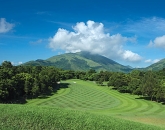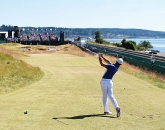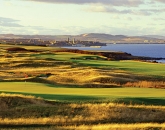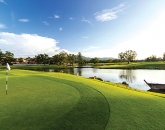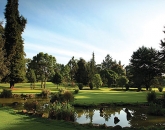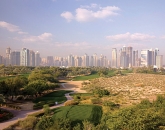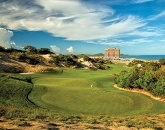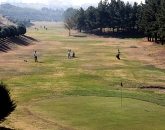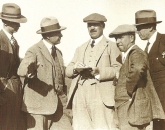Arabian Ranches Golf Club ****1/2
Despite not containing a single water hazard, this is the unquestionably the toughest track in the emirate and really shouldn’t be tackled by beginners or high handicappers. The layout, billed as the only true desert course in Dubai (until the recent opening of the Els Club), is characterized by narrow, rippling landing areas flanked on all sides by an unforgiving wasteland, which invariably comes into play for all but the straightest hitters. The well-bunkered greens complexes here offer another form of defence, featuring huge swales and run-off areas. Then there is the wind; depending on the time of year, a northwesterly Shamal or a southeasterly Sharki whips off the desert creating havoc among Dubai’s golfing populous. It is both brutal and magnificent, but better players will relish the challenge.
+971 4 366 3000, arabianranchesgolfdubai.com
Yardage: 7,691. Par: 72. Architect: Ian Baker-Finch & Nicklaus Design
Greens Fee: US$104-US$125
Four Seasons Golf Club (Al-Badia Course) ****
Windswept Al-Badia is a relatively new layout (even by Dubai’s standards) and a tough addition to the city’s list. Located just 2km from the international airport, this Trent Jones II design presents plenty of risk-reward opportunities with vast lakes and enormous ‘rivers’ of sand coming into play at nearly every turn. The par threes—with their small, well guarded greens—are a particularly strong set of holes while the exciting par-five eighteenth provides a rollicking finish to what is an undeniably stern test.
+971 4-601-0101, fourseasons.com/dubaigolf
Yardage: 7,250. Par: 72.
Architect: Robert Trent Jones II
Greens Fee: US$110-$230
BEST OF THE REST
The Montgomerie Dubai (www.themontgomerie.com), which Colin Montgomerie designed with the late Desmond Muirhead, is worth a visit. Its island green on the par-three thirteenth is reputedly the largest in the world. Jebel Ali Golf Resort & Spa (www.jebelali-international.com), about a forty-minute drive from the city, has nine pretty holes and for years hosted the Jebel Ali Challenge, a star-studded event that acts as the curtain raiser for the Desert Classic. Watch for peackocks that roam the fairways on the eighth and ninth holes. The newest course in Dubai is the Els Club (www.elsclubdubai.com) at Dubai Sports City. Described as a desert links, the course features five sets of tees on each hole and super-fast greens and has received rave reviews since opening earlier this year.
WHERE TO STAY
There are two types of hotel in Dubai: expensive and very expensive. Unfortunately, it’s almost impossible to find anything decent with less than four stars so visitors tend to stick to the plethora of up market resorts and business hotels. The most famous of these is undoubtedly Burj Al-Arab (www.burj-al-arab.com), the world’s first seven star hotel. With its soaring white façade resembling a billowing sail, the hotel stands on its own island nine hundred feet offshore and serves as the architectural symbol of the city. A kaleidoscopic waterfall, mirrors on ceilings of suites, and chauffeur-driven Rolls Royces are the order of the day here. The more conventional Hilton Dubai Creek (www. hilton.com) manages to have both a boutique and business feel. As an added attraction, the hotel is home to Verre, celebrity chef Gordon Ramsey’s first restaurant outside the U.K.
WHERE TO EAT
You can find restaurants serving up dishes from all corners of the globe in Dubai, but visitors often overlook the fine cuisine of the Middle East during their stay. Layali Lubnan on Sheikh Zayed Road is an independent café that gives a rare glimpse of genuine Arabia. Here you’ll find locals and expatriate Arabs smoking shisha (flavored tobacco) while enjoying a game of backgammon. Try the falafel with hummous, washed down with a cup of strong Turkish coffee, for a tasty and invigorating lunch. Lebanese food is justifiably popular the world over, and Ayam Zaman at the Ascot Hotel in Bur Dubai offers delicious repasts at reasonable prices. The restaurant also puts on belly dancing and live music performances throughout the week.
SHOPS AND SPAS
Shopping is a major reason that tourists flock to Dubai; the city is often referred to as the Hong Kong of the Middle East. However, those looking for traditional Arabian markets are in for a disappointment. The creekside souks, which sell a range of gold, jewels and textiles, are a rather sanitized version of their exotic past and a world away from the bustling flea markets of Cairo, Damascus and Tehran. Rather, designer boutiques rule the roost in modern Dubai, and the emrirate’s tourist-friendly tax-free zones ensure that bargains can be had. BurJuman (www.burjuman.com), Wafi City (www.waficity.com) and the Mall of the Emirates (www.malloftheemirates) are three of the city’s biggest malls, each of them crammed with upscale outlets.
Spas have become seriously popular in Dubai as well and can be found in all of the city’s top-end hotels and shopping centres. The Spa at the Shangri-La Hotel (www.shangri-la.com/dubai) is one of the most elegant retreats anywhere, while the exquisite Angsana chain (www.angsanaspa.com) has outlets at both the Arabian Ranches and Montgomerie Dubai golf clubs.
Pages
Click here to see the published article.


